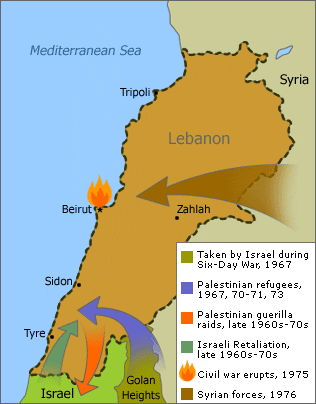Although Lebanon declined to participate in the 1967 Arab-Israeli War (also known as the Six-Day War), a number of conflicts emerged in its aftermath that would lead Lebanon into civil war. Perhaps most significantly, Palestinian refugees fleeing the war landed in Lebanon, where a number of militant groups formed — including the Palestinian Liberation Organization (PLO) — and began launching guerilla attacks on Israel. This led to reprisals from the Israeli Defense Forces (IDF) and divided sentiments within Lebanon — often along religious lines. Muslims, generally, tended to sympathize with the efforts of the Palestinian guerillas, while Christians were inclined to view the guerillas as a threat to national security and government authority. Occasional clashes between the guerillas and the Lebanese Army escalated in 1970 as the government began taking a harsher stance against the militants. Influxes of Palestinian guerillas, exiled from Jordan in 1970 and 1971, only added to the tension, and confrontations between guerillas and the Lebanese army continued — as well as violence between Palestinians and right-wing groups.
Civil war finally broke out on April 13, 1975, in Beirut, when gunmen from a right-wing Christian militia, Phalange, ambushed a bus, killing 26 of its mostly Palestinian passengers — supposedly in retaliation for an earlier shooting at a church. Palestinian forces joined predominantly leftist-Muslim factions and fighting spread from Beirut across the country. In 1976, diplomatic efforts by Syria failed to resolve the conflict until the arrival of Syrian troops that June quelled fighting. In October, Syria’s military presence was validated by Arab summits in Riyadh, Saudi Arabia and Cairo, which established an Arab Deterrent Force (ADF) — composed primarily of Syrian troops — to enforce a ceasefire.
Order was restored, but only temporarily. Guerilla activity in southern Lebanon continued and in March 1978, Israeli forces invaded southern Lebanon in retaliation for a PLO bus bombing in northern Israel. After U.N. demands for Israel’s withdrawal and the creation of an Interim Force in Lebanon (UNIFIL), the Israelis began turning over territory to an allied Christian Lebanese militia. Meanwhile, the Syrian-controlled ADF and various militias continued to battle for control of the country. In 1981, a U.S.-brokered ceasefire between Syria, the PLO, and Israel lasted until PLO rocket attacks on northern Israel and an assassination attempt on the Israeli ambassador to the UK led Israel to invade Lebanon in June 1982, this time driving all the way up to East Beirut to eliminate PLO forces. In August, a multinational force, including U.S. forces, helped oversee PLO withdrawal from Lebanon and, as the country’s various factions became more and more radical, there was an increase in terrorist activities. Hezbollah, a radical Islamic political party, was formed by Shia clerics in 1982, primarily as a result of the Israeli invasion. In 1983, the U.S. Embassy in West Beirut was attacked by a suicide bombing that killed 63 people, and two simultaneous attacks on U.S. and French military barracks left 298 dead. Hezbollah was implicated in these attacks, as well as the abduction of foreigners and the hijacking of aircraft. It was not until the Ta’if Agreement, brokered by the Arab League in 1989, that real progress was made toward peace. After more than 100,000 deaths, the war finally came to an end in 1990.
- Previous: Pre-Civil War
- Next: Under Syrian Dominion



